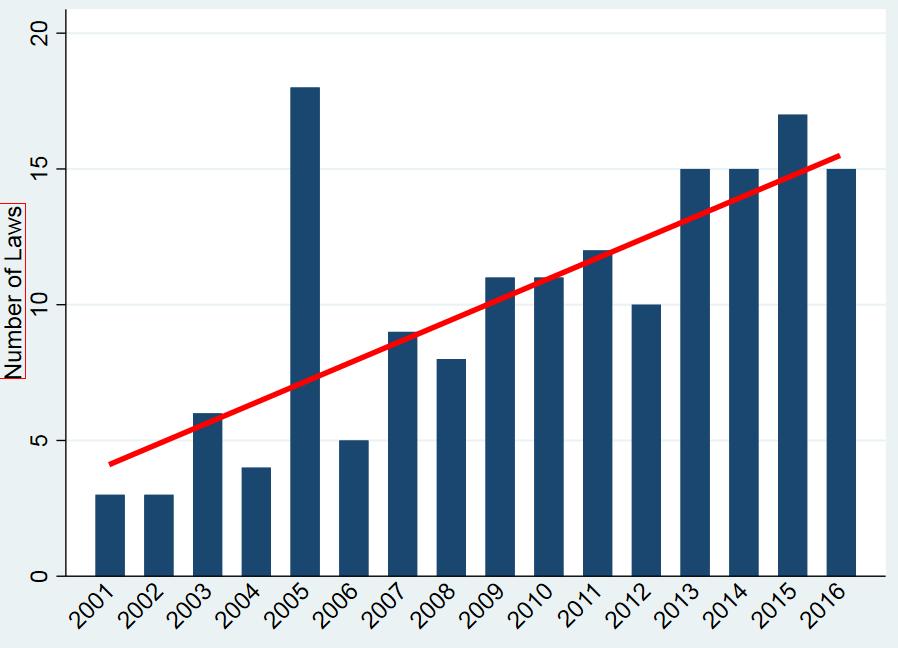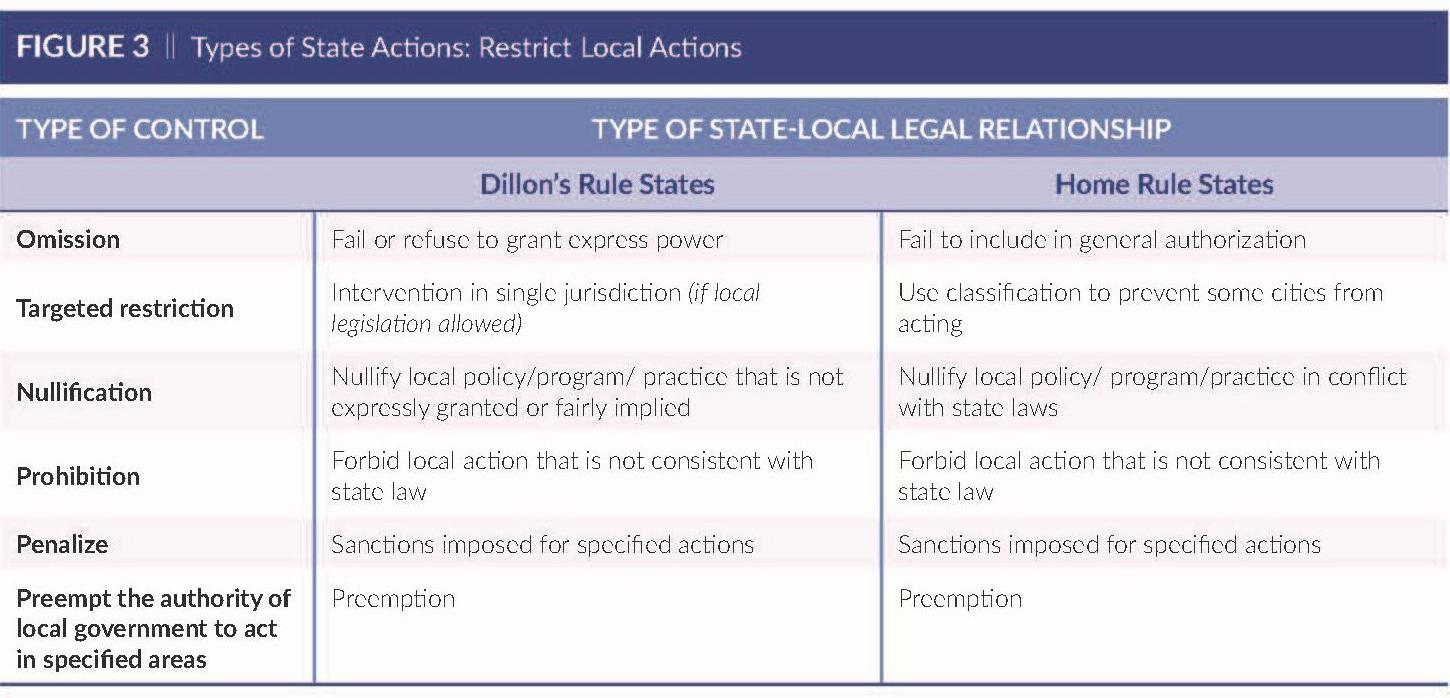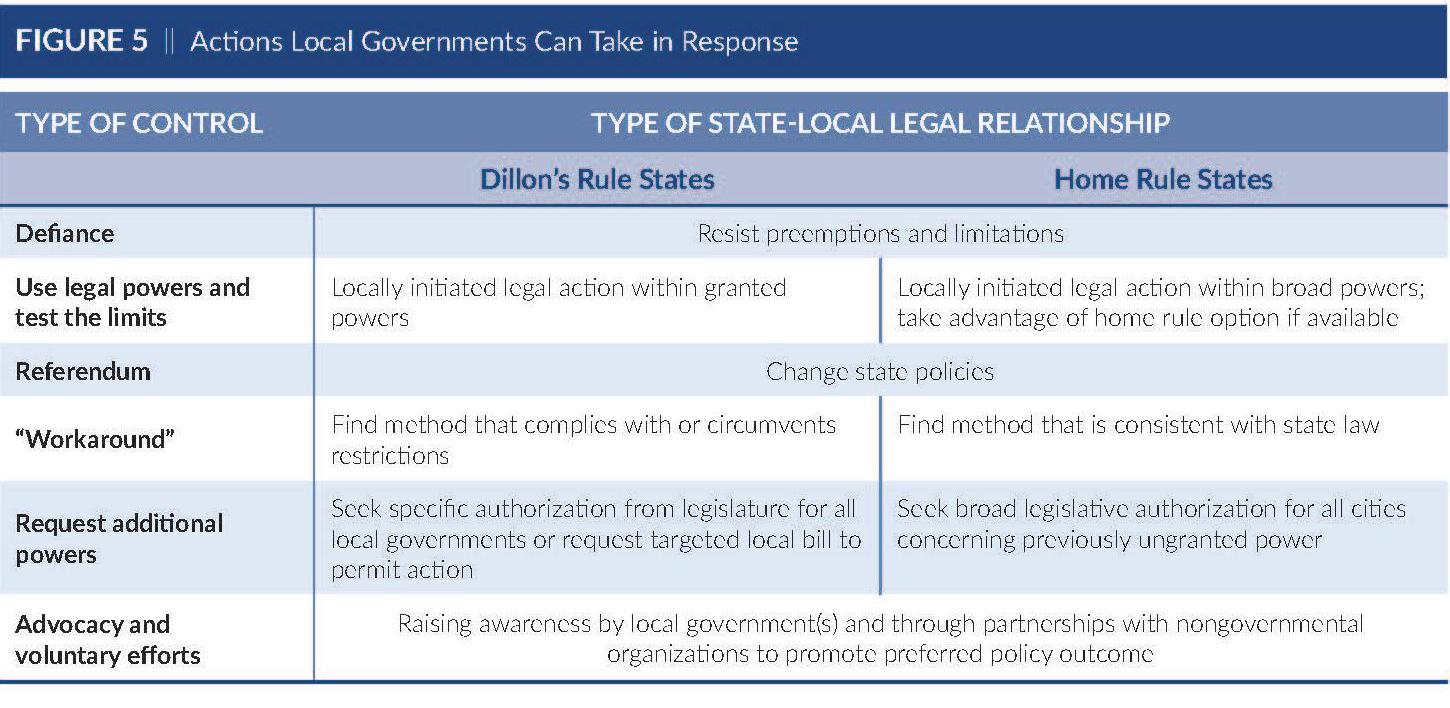
14 minute read
Local Government Option in the Era of State Preemption
Local Government Options in the Era of State Preemption
By David Swindell, James Svara, and Carl Stenberg
Advertisement
Leaders must do more now to preserve the autonomy necessary for representing residents’ needs. Local governments continue to grow in importance in solving public problems at a time of increased politicization in state and federal governments as well as expanded activisminmanylocalgovernments.Butstatesarerapidly placing new kinds of limits on local governments’ability to act.What can local government leaders do?
Localgovernmentshavehistoricallyfacedsuchchallenges asincreasingdemandsforservice,limitedfiscalresources, andcontendingwitheconomicforcesbeyondtheircontrol. Still, local governments remain a primary engine of innovative government services and enjoy high levels of resident trust.
In recent years, state legislatures have encroached on the ability of local governments to meet these challenges and have become increasingly intrusive in local affairs. Reports by the National League of Cities (NLC)1 as well as the Local Government Research Collaborative,2 a partnership of ICMA, theAlliance for Innovation, and the Center for Urban Innovation at Arizona State University, have found significant changes in state-local relations, including: 1) a sharp increase in the number of states involved with this movement, and 2) an increase in the overallnumberoflimitationsplacedonlocalgovernments by their state legislatures.
What options do local managers and elected officials have as they try to tailor local public services to the needs and preferencesofresidents?Thisarticleprovidesanoverview of this changing environment and highlights the array of actions available to local governments as they respond to state limitations.
Dillon’s Ghost
The U.S. Constitution lays out the general two-tiered structure of government in which powers are allocated between the national and the state governments. Yet, it is silent about the powers allocated to local governments. Simply put, there are none. It was not until 1903 that the U.S. Supreme Court formally established an earlier ruling byIowaStateSupremeCourtChiefJusticeJohnDillonas the law of the land, saying:
“Such [municipal] corporations are the creatures—mere political subdivisions—of the state, for the purpose of exercising a part of its powers. They may exert only such powersasareexpresslygrantedtothem,orsuchasmaybe necessarily implied from those granted. . . . They are, in every essential sense, only auxiliaries of the state for the purposes of local government. They may be created, or, having been created, their powers may be restricted or enlarged or altogether withdrawn at the will of the legislature. ”3
This ruling, known as “Dillon’s Rule” or the “creature of the state” doctrine, remains the basic principle underlying state-local relationships today. The courts determine whether a local government could exercise a power. But this is not the end of the story.
While Dillon’s Rule was emerging, western states were going a different direction. Residents and progressive reform groups began championing a competing doctrine by which local governments would have greater authority to act on their own behalf. This doctrine, referred to as “home rule” or “local autonomy, ” asserted that municipalities should have the freedom to implement ordinances and policies in line with local citizen preferencesaslongasnotexpresslyprohibitedbythestate constitution or legislature.
So even with an established U.S. Supreme Court position on the issue, the balance between state control and local
autonomyhascontinuedtoevolveoverthepast115years, with states clustered in “expressly permitted” and “expressly forbidden” categories. Still, the differences were not always clear-cut.Acommon practice in Dillon’s Rule states, for instance, has been to make exceptions through targeted legislation granting powers to a specific government in response to a request from the local legislative delegation.
Dillon Today and theAttack on LocalAutonomy
Several arguments support both philosophical approaches tolocalautonomy.Themostcommonargumentforgreater state control, for instance, is premised on economic development grounds: statewide policy, particularly in terms of regulatory authority, creates a more standardized businessenvironment.Furthermore,aswascommoninthe civil rights era of the late 1960s and 1970s, state governments have intruded on local authority to ensure adherence to state and federal civil rights guidelines.
Proponentsoflocalauthorityarguethatthespateofrecent actions by states to take away local control is in response to special interests (e.g., conservative groups like the American Legislative Exchange Council) and industry groups that are exercising influence with legislatures to circumvent local preferences. Telecommunications companies involved in the rollout of 5G cellular infrastructures, for example, have successfully convinced several legislatures to intervene on their behalf over local governments.
Champions of local autonomy argue that local governments need flexibility to experiment with alternativeandinnovativesolutionstoservicedeliveryand processes. Local control is a better vehicle for expressing resident preferences.As noted by a recent survey byALG Research,residentsagreethatlocalgovernmentsarebetter able to reflect their community ’s values than state government (regardless of party affiliation).4
Recent Research Results
Increased legislative actions affecting local authority have garnered attention from both academic and practitioner researchers. Dr. Lori Riverstone-Newell’s work identified a steady increase in preemption-specific bills across the country from 2011 to 2016.5 NLC’s 2017 report and 2018 updateidentifiednumerouslimitationsacrossmanypolicy areas.
A total of 41 states, for example, had preempted local authority over ride-sharing services, 28 had preempted localminimumwageactions,23hadpreemptedpaidleave policy, and another 20 had restricted municipal broadband authority. Rather than waiting for the courts to resolve a









B or ok ni sg
6 32.69.650 |
iS 24
o | o To er Fll . 1e .558 3.6323
u s lalx F | eV r illmi on | T Rapi id C t
24 y | M bli ank
ww .w b nna era asso setaci oc. m
challenge to a local power under the traditional Dillon’s Rule approach, states are increasingly restricting local control in advance.
We conducted a review of state actions affecting local government authority, beginning with a pilot review of eightstatesfrom2001tomid-2017.Thisreviewexamined all local-related bills enacted into law regardless of the policy focus. We expanded the search to cover all states, but narrowed the focus to only those laws addressing minimum wage policy and telecommunication issues.
We identified 167 laws passed during this period aimed at local government. The vast majority represented a limitationonlocalgovernments(72.5percent)andanother sizeable portion imposed additional requirements on local governments (17.4 percent). Only 10.1 percent expanded local autonomy in any way. More striking is the nearly consistent increase in such legislative activity over this period.
While much of the attention given to the increase in local control limitations has focused on conservative Republican state legislators trying to undermine predominately liberal Democratic central city governments, our data suggest something different. Rather, there appears to be a greater likelihood of state intervention when one party (Republican or Democratic) controls both legislative chambers and the governor’s office in a political “trifecta. ”
Currently, Republicans have far more trifectas than Democrats so there is more intrusion in local affairs by Republicantrifectas.Democratictrifectasalsoareengaged in these activities, including the state of New York preempting the ability of NewYork City from imposing a taxonplasticbags.Therefore,thisriseinstateinterference does not appear to be as simple as party politics as much
FIGURE 1 | State Actions on Local Governments by Year: 2001 to 2016
n=162 (excluding the five cases from early 2017 It Isn’t JustAbout Preemption
Current conversations about state interference and limitations of local autonomy focus on preemption. Yet preemption is only one form of interference with local discretion. In our research, we identify three categories of state actions: permissions, restrictions, and requirements. There are several specific activities within each category, including preemption.

Figures 2, 3, and 4 illustrate the wide range of tools state governmentsusetocontrollocalactivities.Ofthe15states that passed minimum wage legislation from 2001 to 2017, for example, 13 limited local governments’ ability to regulate the minimum wage, one placed a requirement on localities, and one passed expanded local authority. Republican trifectas enacted 77 percent of the minimum wage legislation.
Currently, Republicans have far more trifectas than Democrats so there is more intrusion in local affairs by Republicantrifectas.Democratictrifectasalsoareengaged in these activities, including the state of New York preempting the ability of NewYork City from imposing a taxonplasticbags.Therefore,thisriseinstateinterference does not appear to be as simple as party politics as much as it is an outcome of political party power in each state. It Isn’t JustAbout Preemption
Current conversations about state interference and limitations of local autonomy focus on preemption. Yet preemption is only one form of interference with local discretion. In our research, we identify three categories of state actions: permissions, restrictions, and requirements. There are several specific activities within each category, including preemption.
Figures 2, 3, and 4 illustrate the wide range of tools state governmentsusetocontrollocalactivities.Ofthe15states that passed minimum wage legislation from 2001 to 2017, for example, 13 limited local governments’ ability to regulate the minimum wage, one placed a requirement on localities, and one passed expanded local authority. Republican trifectas enacted 77 percent of the minimum wage legislation.
Scholars, practitioners, think tanks, and the media have written extensively in recent years highlighting cases in each of these situations. But most of the attention has fallen on restrictive actions. North Carolina initiated its “bathroom bill” (H.B. 2) as a nullification of an ordinance passedbythecityofCharlotte.Inthelegislativelanguage, the state preempted all state agencies, including all local jurisdictions and the university system, from passing future workplace legislation deviating from state law.
Penalties are also receiving attention due to some cities’ desires to declare themselves “sanctuary cities” and offering a place of safety to immigrants, refugees, and
WE ARE PLEASED TO ANNOUNCE
Riverside Technologies, Inc. (RTI) is the primary equipment provider for the municipalities that received technical infrastructure improvements through the state sponsored South Dakota Broadband Initiative. end user devices such as computers, laptops and tablets. The SDBI project has now closed and RTI would like to help South Dakota municipalities sustain those technical improvements and Therefore, we are continuing to services to our state’s municipalities and related project called ConnectSD. RTI has a long standing history with public sector, and looks forward to delivering the same level of products and services to which they are accustomed through the ConnectSD project.
PARTNERS: • HP • Cisco • Meraki • VMWARE • EMC • Nimble • Fortinet • APC
Connect with us at: www.riversidetechnologies.com/connectsd/cart
HARDWARE: • Laptops & Chromebooks • Desktops & Workstations • Servers • Storage • Access Points • Printers DEPLOYMENT: • Hard Drive imaging • Asset tagging • Google Management Console • Chromebook Elite Services CUSTOMIZATION: • Embroidery • Laser Engraving • Decals • Banners • Carrying Cases & Backpacks INTEGRATION: • Active Directory Migration • Wireless Assessment • Network Assessment • Managed IT Services • Green Delivery • RTI Backup
FOR MORE INFORMATION, CONTACT RTI TODAY: 866-804-4388 | 866-812-5370 www.RiversideTechnologies.com
Passion | Creativity | Teamwork



others threatened by deportation. Texas Governor Greg Abbott, for example, signed a law in 2017 to preempt Texascitiesfromdeclaringthemselvesassanctuarycities, which included language that penalizes police officials who fail to cooperate with federal immigration officials with removal from office, fines, and prison time.
What’s a City to Do?
Given the encroachment of state governments into the actions of local jurisdictions, local officials face the decision of how best to respond. They can simply do nothingandgiveintothestate’sdesires,regardlessofhow wellorpoorlythestate’sactionsalignwiththepreferences of a local community. But they have a range of other options.
The NLC report recommends that local officials “choose their preemption battles wisely. ” This requires communication with state officials to determine the extent to which there is an opportunity to shape legislation moving forward. Local officials should address the preemption narrative to better frame debate.
In our work, we highlight six additional options. Some of

these vary depending on the type of state-local legal arrangement. statelegislaturecanpassnewlawstocircumventtheintent of the referendum.
Theseoptionscomewithcostsanddifferentlikelihoodsof success.Defyingthestatelegislatureisariskyproposition and ties to the importance of the NLC recommendation to choose a preemption battle wisely. Local officials need to understandhowlikelyandinwhatwaysthestatewillpush back.
A local government can also use its own legal powers to test the limits of state control in a particular policy or service area by making a proactive case that it has the authority to act. Being the first government in a state to enter a new policy area does not necessarily mean that it is not permitted. The city of Seattle, Washington, recentlypassedamunicipalincometax,afirstinthestate, which is under review by the state supreme court to determine if Washington cities have the right to levy such a tax.
Still, challenges can be costly if unsuccessful. In North Carolina since 2011, a judge may award attorneys’ fees and court costs to challengers that prevail in suits against local governments if the judge finds that the local government “acted outside the scope of its legal authority. ”6
A more challenging path is to pursue a statewide popular referendum designed to overturn or circumscribe a state intervention. There are three significant challenges to this approach. First, only 26 states have access to this form of directaction.Second,anindividualcityisrarelyequipped to coordinate a statewide campaign on an issue. This meansthecitywillhavetopartnerwithothersandbuilda coalition of supporters in other jurisdictions or organizations, which is not a common practice for local officials. Finally, even if a referendum were to succeed, a A more likely pathway to success is the “ workaround. ” Generally, this option comports with the letter of the law, but it still tries to achieve the desires of the local

jurisdiction. As more states have considered “bathroom bills” similar to North Carolina’s, some localities have already implemented various workarounds to the gender issues, replacing group bathrooms with individual bathrooms available to everyone equally.
Local governments have the option to ask their state legislators to introduce legislation on their behalf. This grant of power can be targeted at a single jurisdiction, but morelikelywouldempoweractionbyallcitiesorcounties that joined in the request. This was a common tactic for citiesandcountiesinDillon’sRulestatesonissuesrelated to access to such new revenue tools as a county option income tax, certain economic development tools, or other specific powers not normally available to local governments.Ittypicallydependedonawillingnessofthe legislature to adopt a special act supported by the local legislative delegation as a “legislative courtesy. ” Polarization in legislatures makes such grants unlikely if the party majority in the local delegation is different than the legislative majority. Seeking a local bill today requires negotiation with state officials and signals the local government’s interest in entering an area where they do not have clear authority. Perhaps the option with the greatest general likelihood of success is working with other jurisdictions or organizations to promote local government goals at the statehouse. This closely aligns with NLC’s recommendation to address the preemption narrative. Local governments should work with their statewide partners at their state league of municipalities, state association of counties, state chapter of ICMA, or the equivalents of these entities.
These organizations can be useful partners in many ways. For instance, many serve as a watchdog on legislative actions. Further, they can lobby on behalf of local government interests broadly. They can help coordinate a coherent message on pending legislation to state officials onbehalfoflocalgovernments,sharinglessonsfromother states.
Inthisrole,theycancollaborateondraftinglegislationand developingcompromiselanguagewhennecessarytoblunt the worst effects of state actions on local governments. They can also help coordinate appeals to local residents and stakeholder groups to help legislators understand the implications of their actions on communities.
Here
Today.
We are celebrating 80 years! We are pleased with the success we’ve had throughout the years and thrilled for what is yet to come. We couldn’t of done it without you! Thank you for trusting in us to partner with you as your consulting engineering and land surveying advisors.
Here
Tomorrow.
Clark-eng.com Sioux Falls | Aberdeen | Pierre | Watertown | Minneapolis
The current environment is in flux regarding the balance between state control and local autonomy. States are increasingly interfering in local actions and placing more limits on what local jurisdictions can do, regardless of the preferences of local residents. These actions take many forms, but local officials are not completely unable to respond.
The tools we have identified highlight several options availabletolocalgovernmentsandtheiralliestoengagein this challenge to local autonomy. There is evidence to suggest that state legislative activity is not going to slow any time soon. Local government leaders, therefore, must do more now if they want to preserve the autonomy necessary for representing the desires of their residents.
David Swindell is associate professor and director, Center for Urban Innovation,Arizona State University, Phoenix,Arizona (david.swindell@asu.edu). James Svara, formerly a faculty member at Arizona State University, is visiting scholar, University of North Carolina at Chapel Hill, residing in Durham, North Carolina (James.Svara@sog.unc.edu). Carl Stenberg is professor, University of North Carolina at Chapel Hill, Chapel Hill, North Carolina (stenberg@sog.unc.edu).
This article is reprinted with special permission from LGR: Local Government Review, a special section of the July 2018 Public Management (PM) magazine, copyrighted and published by ICMA, the International City/County Management Association, Washington, D.C. LGR is available for purchase through the ICMA Bookstore at https://icma.org/july-2018-LGR.
Endnotes 1 DuPuis, N., et al. (2018). City Rights in an Era of Preemption:AState-by-StateAnalysis.Washington, D.C.: N 2 ational League Swindell, D. of Cities. , Stenberg, C., & Svara, J. (2017). NavigatingtheWatersBetweenLocalAutonomyandState Preemption. Phoenix, AZ: Local Government Research Collaborative. 3 Atkins v. Kansas, 181 U.S. 207 4 National Employment Law Pr (1903). oject. (2018, March 1). Poll Results: Groundbreaking New Polls on Local Democracy, Home Rule, MinimumWage [Press Release]. Retrieved from http://www.nelp.org/news-releases/pollresults-groundbreaking-new-polls-on-local-democracyhome5 rule-minimum-wage.
Riverstone-Newell, L. (2017).
“The Rise of State Preemption Laws in Response to Local Policy Innovation. ” Publius: The Journal of Federalism, 47(3): 403–25. 6
Bluestein, F. (2012). “Is North Carolina a Dillon’s Rule State?” Retrieved from https://canons.sog.unc.edu/isnorth-carolina-a-dillons-rule-state.


